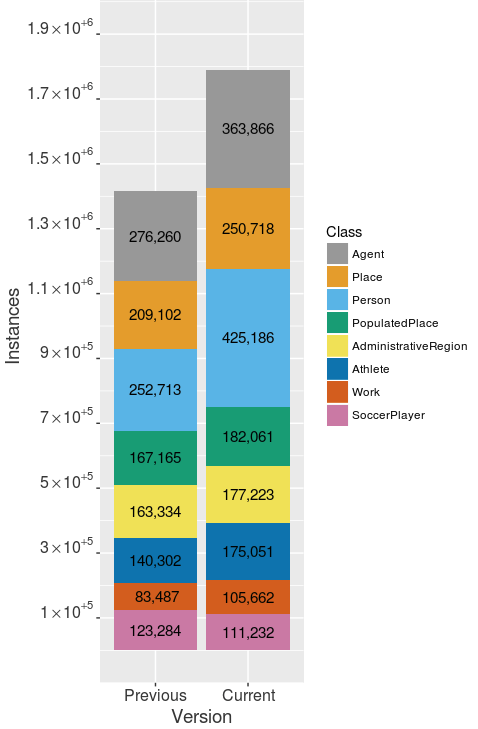On June 18th 2018 we updated the data available in the SPARQL endpoint.
The following SPARQL query retrieves the number of instances for each class in the DBpedia ontology.
SELECT ?class (COUNT(?s) AS ?count) WHERE {
?s a ?class .
filter (strstarts(str(?s), "http://es.dbpedia.org/resource")) .
filter (strstarts(str(?class), "http://dbpedia.org/ontology"))
} GROUP BY ?class ORDER BY DESC(?count)
The following figure shows the increase on the number of instances from the previous version (DBpedia 2014) to the new one (DBpedia 10-2016) for the most populated classes.
Por instance, for class 'Agent' we have moved from 276,260 instancias to 363,866.
 |
If we compare with the previous data update, in which we went from version 3.9 to the 2014 version, we must notice the following:
- In the 2014 update, information from both es.dbpedia.org and dbpedia.org was included in the SPARQL endpoint. Therefore, the number of resources of a given data type was somewhat higher than twice the number in 2013 (DBpedia 3.9).
- To avoid this duplicity, we have included in the SPARQL query the filtering of the variable ?s, counting only those that begin with es.dbpedia.org
- Do not try to execute this query in the SPARQL endpoint. It will result in a timeout because it is very heavy. We have been able to execute it because we can make queries in an environment without timeout restrictions.
- We have also updated the version of the triple store (Virtuoso), from version 6 to version 7. This has caused some problems because the namespaces known by Virtuoso have changed. For example, the namespace dbpedia-owl was previously known by Virtuoso, but now it is not included and must be specified in the queries by setting PREFIX dbpedia-owl: <http://dbpedia.org/ontology/>



